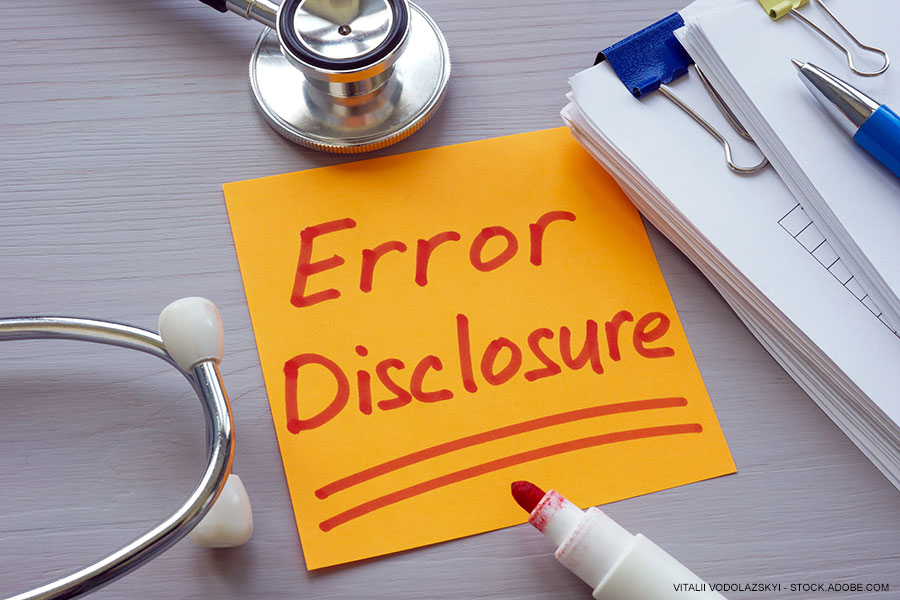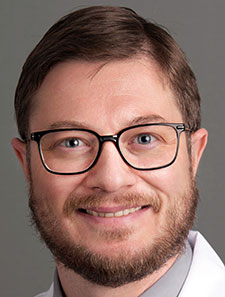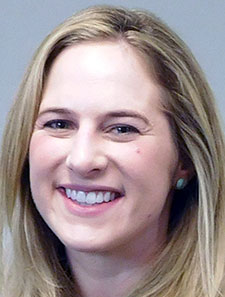 Many entering the medical profession are perfectionists, unaccustomed to making serious mistakes.1 Medical errors, however, are inevitable and multifactorial.2 We fear errors due to the cost to our patients and our professional careers. We pledge to do no harm, but no practitioner is infallible. How we manage mistakes can shape our careers, especially when our first error occurs.
Many entering the medical profession are perfectionists, unaccustomed to making serious mistakes.1 Medical errors, however, are inevitable and multifactorial.2 We fear errors due to the cost to our patients and our professional careers. We pledge to do no harm, but no practitioner is infallible. How we manage mistakes can shape our careers, especially when our first error occurs.
At each level of new responsibility, there is a transition to independent decision making that can be daunting and breed insecurity. With that insecurity, confronting near-misses and errors may feel personal, especially during the processes of closely examining the decisions that led to the mistake. This may build throughout a career, leading to burnout. Demystifying medical errors and creating a culture that allows for growth leads to best practices for patients and healthier clinicians.
The second victim
The second victim refers to the trauma experienced by healthcare practitioners in events that endangered a patient, or the first victim.3 Clinicians often treat errors as a personal failure, making it difficult to process, learn, and improve. Qualitative studies describe the stages of confronting an error as the initial accident response, intrusive reflection, restoring personal integrity, enduring the inquisition, emotional first aid, and eventually moving on.4 When physicians are unable to process errors, shame and guilt can progress, and recovery can be delayed or not possible.
It’s important to acknowledge the cognitive burden, often a precursor to burnout, of processing medical errors. Most often, practitioners are balancing numerous clinical duties with initial analysis of the mistake and its consequences. The likelihood of making another error is directly related to factors that feed into burnout, including decreased confidence, anxiety, fear, and distraction.5
From the time the second victim phenomenon was described in literature, resources and structures have been developed to destigmatize the effects of mistakes on healthcare workers and connect them with appropriate support. There is no single strategy to recover from an error. However, we should be reassured that the emotional response is shared and expected, regardless of clinical experience or personal attributes of a clinician.
When medical error occurs
When a medical error occurs, it’s an unsettling moment for everyone involved, but it can lead to an opportunity for growth, learning, and systemic improvement. Peer review often occurs after an error, in which a team of physicians evaluates the case in a confidential setting, discussing what went wrong, what could have contributed, and how similar incidents might be prevented in the future.6 This process allows peers to learn from each other in a non-punitive environment, fostering personal and collective responsibility.
Cases with significant learning potential are often brought to a morbidity and mortality (M&M) conference, designed to encourage open dialogue, promote transparency, and support a culture of safety, enabling clinicians to confront mistakes without shame and discuss how they can collectively improve.7 These conferences are often feared, as when done poorly, they can shift to practitioner blame. By focusing on education and preventive strategies, M&M conferences remind us that errors are part of the journey; that resilience and humility are essential to growth in medicine.
At a more formal level, hospitals may conduct a root cause analysis (RCA) to evaluate underlying systemic factors that may have contributed to an error through deep and methodical examinations of the incident.8 RCAs look beyond individual actions toward hidden risks within the processes, protocols, or environments that can be modified to reduce future errors. The goal is safety and quality improvement, not individual error, reinforcing that medicine is a complex web of interconnected actions and decisions.
Occasionally, a medical error may result in a medical malpractice claim, bringing the event under legal scrutiny. While this can feel daunting, it underscores the importance of transparency, accountability, and ongoing learning in healthcare. Malpractice cases highlight how deeply patients and families place their trust in healthcare and how critical it is to uphold that trust.
Disclosure of errors
Psychological safety extends to the admission of errors, and it is crucial that we create a space for ourselves, our colleagues, and our learners in which we can discuss our mistakes with candor and empathy. Physicians need tools to learn from errors and forgive themselves to move forward.
No matter what a practitioner’s career stage, knowing the resources in the healthcare system for sharing and disclosing errors is vital to protect oneself, but also to process the emotions associated with the error. Errors must be disclosed to leadership, the risk management team, and the patient involved.9 This can feel overwhelming and intimidating, especially when these errors are accompanied by guilt and shame.
Interdisciplinary teams extend beyond the hospital floor. When a mistake occurs, seeking out support from trusted leadership is the first step. This may be section or division leadership, the chief medical officer, or, for trainees, clerkship directors, chief residents, associate program directors, and the program director. The risk management team will help devise a strategy for disclosure to patients and their families. They are an excellent source of knowledge and support for questions about patients, even when a mistake has not occurred. Familiarity with the risk management team can mitigate the anxiety associated with contacting them after an error. A malpractice claim may feel like the ultimate failure, but practitioners should rely on the hospital’s established processes and expertise for support.
A culture of openness
As a medical system, it is imperative that we create a culture in which the ubiquity of medical error is acknowledged and in which errors are discussed openly without fear of retribution and negative consequences. The culture of openness starts from the top of leadership and should permeate down to practitioners. This can be in the form of initial orientations, structures for routine check-ins, and systems for immediate support. Leaders can refer to additional resources such as peer support networks, counselors, and employee-assistance programs.
Some institutions have established multidisciplinary, second-victim, rapid-response teams to provide immediate relief for acute events.10,11 When larger systemic structures are not available, it falls on local leaders to support colleagues and trainees. Infrastructure should proactively identify support needs in high-risk clinical areas. This expands the culture of safety in healthcare and can help rapidly address burnout from a universal phenomenon to prevent the cycle of further errors.
Emotional support from colleagues, mentors, and supervisors provides the biggest impact. Debriefing is crucial to coping with guilt, anger, loss, and other natural emotional responses.12 Debriefs can be structured to provide support and additional resources, normalize the outcome, and develop a plan for closure and growth.
Conclusion
The methods and structures put in place to help us learn from our mistakes, while crucial to improving the quality of care our patients receive, will never eliminate the existence of medical error. Human nature, with its unique cognitive biases and imperfect systems, makes medical error universal. Peer review, M&M, RCA, and, in rare cases, legal review play a critical role in the process of learning from mistakes and safeguarding the quality of care we strive to provide. Support from leadership, risk management, and peers will aid the second victim in preventing burnout. A culture of openness and systems that respond to errors in real time can lessen the impact of medical errors on both providers and patients.

Dr. Molitch-Hou

Dr. Plesac

Dr. Parekh

Dr. Skarda
Dr. Molitch-Hou is an assistant professor, the director of hospital medicine sub-internship, core faculty for the internal medicine residency program, and co-director of the care transition clinic at the University of Chicago Medical Center in Chicago. Dr. Plesac is a hospitalist, assistant professor of medicine in the division of hospital medicine, and the program director of the internal medicine residency program at the University of Minnesota in Minneapolis. Dr. Parekh is a graduating internal medicine resident at the University of Chicago in Chicago and a future hospitalist. Dr. Skarda is a hospitalist and primary care internal medicine physician at HealthPartners in Regions Hospital in Saint Paul, Minn. She is also an associate program director for the University of Minnesota internal medicine residency program and chair of the hospital credentials committee at Regions Hospital in Saint Paul, Minn.
References
- Johnson KM, et al. Excellent vs excessive: helping trainees balance performance and perfectionism. J Grad Med Educ. 2023;15(4):424-427. doi:10.4300/JGME-D-23-00003.1.
- Kohn LT, Corrigan JM, Donaldson MS, eds. To Err is Human: Building a Safer Health System. Washington (DC): National Academies Press (US); 2000. https://doi.org/10.17226/9728.
- Wu AW. Medical error: the second victim: The doctor who makes the mistake needs help too. BMJ. 2000;320(7237):726-727. https://doi.org/10.1136/bmj.320.7237.726.
- Ozeke O, et al. Second victims in health care: current perspectives. Adv Med Educ Pract. 2019;10:593-603. https://doi.org/10.2147/AMEP.S185912.
- Shanafelt TD, et al. Burnout and medical errors among American surgeons. Ann Surg. 2010;251(6):995-1000. https://doi.org/10.1097/SLA.0b013e3181bfdab3.
- Margaron FC, et al. Peer review and its ethical implications. Semin Pediatr Surg. 2021;30(5):151098. https://doi.org/10.1016/j.sempedsurg.2021.151098.
- Orlander JD, et al. The morbidity and mortality conference: the delicate nature of learning from error. Acad Med J Assoc Am Med Coll. 2002;77(10):1001-1006. https://doi.org/10.1097/00001888-200210000-00011.
- Joint Commission on Accreditation of Healthcare Organizations. Root Cause Analysis in Health Care : Tools and Techniques. Oakbrook Terrace, IL: Joint Commission Resources; 2003. Available online at: http://archive.org/details/rootcauseanalysi0000unse. Accessed April 25, 2025.
- Gallagher TH, et al. Patients’ and physicians’ attitudes regarding the disclosure of medical errors. JAMA. 2003;289(8):1001-1007. doi:10.1001/jama.289.8.1001.
- Edrees H, et al. Implementing the RISE second victim support programme at the Johns Hopkins Hospital: a case study. BMJ Open. 2016;6(9):e011708. doi:10.1136/bmjopen-2016-011708.
- Scott SD, et al. Caring for our own: deploying a systemwide second victim rapid response team. Jt Comm J Qual Patient Saf. 2010;36(5):233-240. doi:10.1016/S1553-7250(10)36038-7.
- Pratt SD, Jachna BR. Care of the clinician after an adverse event. Int J Obstet Anesth. 2015;24(1):54-63. doi:10.1016/j.ijoa.2014.10.001.